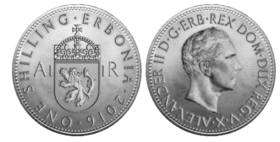Pound marten
| Pound marten | |
|---|---|
| Pound marten | |
 A typical silver coin with a denomination of one shilling, showing the reverse and obverse. | |
| ISO 4217 | |
| Code | GNP |
| Denominations | |
| Subunit | |
| 1⁄20 | Shilling |
| 1⁄12 | Penny |
| 1⁄4 | Farthing |
| Symbol | £ |
| Shilling | / (print) or ∫ (handwritten) |
| Penny | d (print) or ₰ (handwritten) |
| Demographics | |
| User(s) | |
The pound marten (symbol: £) is the national currency of Great Nortend. It is subdivided into 20 shillings (symbol: / or ∫) and 240 pennies (plural: pence; symbol: d or ₰). The issuance of the currency is strictly controlled by His Majesty's Treasury, in conjunction with the King's Bank of Cadell in accordance with the Steady State Plan which aims to limit economic growth to socially manageable levels.
The specific epithet marten distinguishes the pound marten from other currencies either historically or presently named the pound. It derives from the cross marten, a heraldic cross and symbol of the House of Anthord who have used it on coinage since the reign of George I. The cross is depicted as a hallmark on all Nortish silver coins owing to their content of marten silver. Marten silver is an alloy of silver used specifically for coinage purposes, being made up of 11 parts silver with 1 part copper.
Coins
Coins have traditionally been minted by a number of private moneyers, working under charter from the King. By the 19th century, the main coins in circulation were 1/4d, 1/2d, 1d, 3d, 6d and 12d. A coin of 60d or 5/- known as the quarter was also infrequently seen, minted for commemorative purposes. By 1942, the so-called 'crown' of two shillings, and half quarter of two shillings sixpence put into general circulation. Since 1934, only the Royal Mint, the Royal Hambrian Mint and the City Mint are authorised to mint coins.
All coins ever minted in denominations of the pound marten since the Resizing in the early 19th century are legal tender and most still circulate through the economy. There are approximately £2,000 million coins in circulation.
Reverse designs
Reverse designs have been mostly standard since 1903 with the redesign for the accession of Edmund IX, with the introduction of the “Roses and Strawberries Pattern”. They are, however, periodically resculpted by new sculptors. The present designs are :—
- 1/4d (One Farthing): Cross fleury with pips
- 1/2d (Halfpenny): Cross fleury with roses
- 1d (One Penny): Cross fleury with strawberries
- 3d (Threepence): Three roses erupting from a coronet
- 6d (Sixpence): Six strawberries erupting from a coronet
- 1/- (One Shilling): Crowned royal escutcheon surrounded by roses
- 2/- (Two Shillings): Crowned royal escutcheon surrounded by strawberries
- 2/6 (Half Crown): Full royal coat of arms
- 5/- (Crown): Four crowned royal eschutcheons in the shape of a cross with roses and strawberries
- 10/- (Half Guilder): St Edmund the King with orb and sceptre and roses
- £1 (Guilder): St Edmund the King with orb and sceptre and strawberries
Banknotes
Banknotes are issued by the King's Bank of Cadell and various other banks. Though they are not legal tender for payment of a debt, banknotes are widely considered money as they are always convertible to coinage at all banks. Banknotes are commonly available in denominations of 5/-, 10/-, £1, £2, £5 and £10. Banknotes above £1 are rarely used, however, and not always accepted owing to their very high value (£10 being equivalent to ~1,200 US dollars). Banknotes are made of a special linen-cotton blend paper, with relatively advanced security features to prevent forgery, such as metallic strips, watermarks, micro-printing, tactile printing and holograms.

